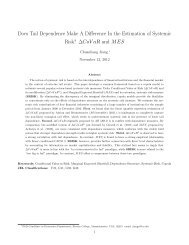A Value-based Pricing Perspective on Value ... - Boston College
A Value-based Pricing Perspective on Value ... - Boston College
A Value-based Pricing Perspective on Value ... - Boston College
Create successful ePaper yourself
Turn your PDF publications into a flip-book with our unique Google optimized e-Paper software.
<str<strong>on</strong>g>Value</str<strong>on</strong>g> Communicati<strong>on</strong><br />
Ultimately, the objective of value communicati<strong>on</strong> is to raise customers’ willingness to<br />
pay for the value they receive. To develop a value communicati<strong>on</strong> strategy, you first need to<br />
identify where in the buying process you intend to influence value percepti<strong>on</strong>. Perhaps you are<br />
trying to get customers to recognize that they have a need large enough to justify making a<br />
purchase. Or you may believe that there is plenty of primary demand (people intending to<br />
purchase) but that you need to increase your share of that demand. If you already have share in a<br />
repeat purchase market but are fighting off the threat of competiti<strong>on</strong>, you want to influence<br />
percepti<strong>on</strong>s of the task of trying an unknown, unproven supplier. Imagining where in the buying<br />
process you are trying to influence customers enables you to define what alternatives a customer<br />
is likely to be c<strong>on</strong>sidering, how knowledgeable they are already likely to be about your brand<br />
and product category, and what you offer, if anything, that differentiates you positively or<br />
negatively from those alternatives.<br />
The differentiati<strong>on</strong> that distinguishes your offering is what can drive value percepti<strong>on</strong>s<br />
and price for your offering if you can influence how customers understand it. The tactics you<br />
will use to influence them depends <strong>on</strong> two things: the relative cost of search for those<br />
differentiating attributes by your target customers and the type of benefits sought: ec<strong>on</strong>omic or<br />
psychological. These define the 2x2 matrix shown in Exhibit 5-1.<br />
[INSERT EXHIBIT 5-1 HERE]<br />
The relative cost of search is the cost (financial and n<strong>on</strong>-financial) for a customer to<br />
determine the features and performance differences across brands relative to that customer’s<br />
expenditure in the category (Stigler 1961; Nels<strong>on</strong> 1970). Multiple factors drive the relative cost<br />
of search.<br />
Searchability-- Differences across brands of some goods are easy to determine before purchase.<br />
Such goods are called “search goods” because buyers can search thru informati<strong>on</strong> about the<br />
products and services to draw accurate c<strong>on</strong>clusi<strong>on</strong>s prior to purchase about their differentiating<br />
attribute. Examples of obvious “search goods” are commodity chemicals, office furniture,<br />
internet service providers, and home equity loans. In c<strong>on</strong>trast, “Experience goods” have<br />
differentiating attributes that are more difficult to evaluate across brands, requiring a substantial<br />
commitment to purchase and use before being able to evaluate their performance. Examples of<br />
“experience goods” include most services, such as management c<strong>on</strong>sulting, auto repair and<br />
package delivery, as well as some products, such as pharmaceuticals, batteries, and home<br />
appliances. Some products are complex hybrids with both search and experience attributes, such<br />
as automobiles.<br />
Trialability—How easy is it to purchase and use a small amount of a brand and infer<br />
performance from that. Experience goods that <strong>on</strong>e can try without making a full purchase<br />
commitment can have a cost of search as low as that of search goods. Ski shops will rent, for a<br />
reas<strong>on</strong>able daily fee, various brands of high performance skis that <strong>on</strong>e can try for a day. You<br />
can purchase a small can of paint and try it before you buy enough to paint an entire house. You<br />
can buy <strong>on</strong>e bottle each of different brands of spaghetti sauce before selecting a favorite for<br />
weekly purchase.<br />
6

















